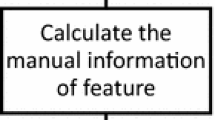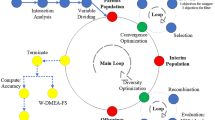Abstract
To solve the problems of limited expression of feature information in a discrete evaluation sequence, the high cost of model optimization, and insufficient discrimination information to detect missing classes, a zero-small sample capability evaluation (ZES) method based on model structure self-optimization is proposed. Spatial transformation of the gram angle field was used to optimize the information richness and data correlation of the sample sequences. A multi-mechanism fusion strategy (MFS) was designed for self-optimization of the visual feature extraction model. Through self-adaptive global optimization of ten key parameters in the model, a computational model suitable for small samples and with self-learning ability was constructed. Sample semantic attributes and a visual-semantic feature mapping were constructed, and the unseen class labels were predicted according to cosine similarity. The experimental results verify the feasibility and effectiveness of the proposed method in the aspects of model adaptive optimization and evaluation of unseen samples and provide a new idea for constructing a comprehensive evaluation, prediction, and diagnosis system and method design in related fields.














Similar content being viewed by others
References
Zhang YM, Ma L, Sun HY et al (2017) Programming, practice and innovation ability evaluation method based on fuzzy neural network. Res Explor Lab 36(02):18–22
Feng X, Wei YJ, Pan XL et al (2020) Academic emotion classification and recognition method for large-scale online learning environment—based on A-CNN and LSTM-ATT deep learning pipeline method. Inter J Env Res Pub Heal 17(6):1941. https://doi.org/10.3390/ijerph17061941
Mohamadi S, Lattanzi D, Azari H (2020) Fusion and visualization of bridge deck nondestructive evaluation data via machine learning. Front Mater 7:576918. https://doi.org/10.3389/fmats.2020.576918
Phan HC, Duong HT (2021) Predicting burst pressure of defected pipeline with Principal Component Analysis and adaptive Neuro Fuzzy Inference System. Int J Pres Ves Pip. https://doi.org/10.1016/j.ijpvp.2020.104274
Fu ZY, Xiang T, Kodirov E et al (2018) Zero-shot learning on semantic class prototype graph. IEEE T Pattern Anal 40(8):2009–2022. https://doi.org/10.1109/TPAMI.2017.2737007
Khan A, Sohail A, Zahoora U et al (2020) A survey of the recent architectures of deep convolutional neural networks. Artif Intell Rev 53(8):5455–5516. https://doi.org/10.1007/s10462-020-09825-6
Zhang JM, Wang W, Lu CQ et al (2020) Lightweight deep network for traffic sign classification. Ann Telecommun 75(7-8):369–379. https://doi.org/10.1007/s12243-019-00731-9
Wang Y, Yang J, Liu M et al (2020) LightAMC: lightweight automatic modulation classification via deep learning and compressive sensing. IEEE T Veh Technol 69(3):3491–3495. https://doi.org/10.1109/TVT.2020.2971001
Tripathy RK, Bilionis I (2018) Deep UQ: Learning deep neural network surrogate models for high dimensional uncertainty quantification. J Comput Phys 375:564–588. https://doi.org/10.1016/j.jcp.2018.08.036
Zhu YH, Zabaras N (2018) Bayesian deep convolutional encoder-decoder networks for surrogate modeling and uncertainty quantification. J Comput Phys 366:415–447. https://doi.org/10.1016/j.jcp.2018.04.018
Han Y, Sunwoo L, Ye JC (2020) k-space deep learning for accelerated MRI. IEEE T Med Imaging 39(2):377–386. https://doi.org/10.1109/TMI.2019.2927101
Solomon O, Cohen R, Zhang Y et al (2020) Deep unfolded robust PCA with application to clutter suppression in ultrasound. IEEE T Med Imaging 39(4):1051–1063. https://doi.org/10.1109/TMI.2019.2941271
Christodoulidis S, Anthimopoulos M, Ebner L et al (2017) Multisource transfer learning with convolutional neural networks for lung pattern analysis. IEEE J Biomed Health Inform 21(1):76–84
Wang JP, Gou L, Zhang W et al (2019) DeepVID: deep visual interpretation and diagnosis for image classifiers via knowledge distillation. IEEE T Vis Comput Gr 25(6):2168–2180. https://doi.org/10.1109/TVCG.2019.2903943
Xue JK, Shen B (2020) A novel swarm intelligence optimization approach: sparrow search algorithm. Syst Sci Control Eng 8(1):22–34. https://doi.org/10.1080/21642583.2019.1708830
Ge ZJ, Wang XX, Xu ZS (2021) A novel order evaluation model with nested probabilistic-numerical linguistic information applied to traditional order grabbing mode. Appl Intell. https://doi.org/10.1007/s10489-020-02088-2
Wang SX, Ge LJ, Cai SX et al (2018) Hybrid interval AHP-entropy method for electricity user evaluation in smart electricity utilization. J Mod Power Syst Cle 6(4):701– 711
Barchielli A, Gregoratti M, Toigo A (2018) Measurement uncertainty relations for discrete observables: relative entropy formulation. Commun Math Phys 357(3):1253–1304. https://doi.org/10.1007/s00220-017-3075-7
Pelabon C, Hilde CH, Einum S et al (2020) On the use of the coefficient of variation to quantify and compare trait variation. Evol Lett 4(3):180–188. https://doi.org/10.1002/evl3.171
Barra S, Carta SM, Corriga A et al (2020) Deep learning and time series-to-image encoding for financial forecasting. IEEE-CAA J Automatic 7(3):683–692. https://doi.org/10.1109/JAS.2020.1003132
Sun C, Ma M, Zhao ZB et al (2019) Deep transfer learning based on sparse autoencoder for remaining useful life prediction of tool in manufacturing. IEEE Trans Industr Inform 15(4):2416–2425
Tolabi HB, Ara AL, Hosseini R (2021) An enhanced particle swarm optimization algorithm to solve probabilistic load flow problem in a micro-grid. Appl Intell 51(3):1645–1668. https://doi.org/10.1007/s10489-020-01872-4
Kaur G, Arora S (2018) Chaotic whale optimization algorithm. J Comput Des Eng 5(3):275–284. https://doi.org/10.1016/j.jcde.2017.12.006
Martinho-Corbishley D, Nixon MS, Carter JN (2019) Super-Fine attributes with crowd prototyping. IEEE T Pattern Anal 41(6):1486–1500. https://doi.org/10.1109/TPAMI.2018.2836900
Hayashi T, Fujita H (2021) Cluster-based zero-shot learning for multivariate data. J Amb Intel Hum Comp 12(2):1897–1911. https://doi.org/10.1007/s12652-020-02268-5
Boveiri HR, Elhoseny M (2020) A-COA: an adaptive cuckoo optimization algorithm for continuous and combinatorial optimization. Neural Comput Appl 32(3):681– 705
Wang XS, Huang WW, Cheng YH (2020) Multisource domain attribute adaptation based on adaptive multikernel alignment learning. IEEE T Syst Man CY-S 50(5):1897–1908. https://doi.org/10.1109/TSMC.2018.2791603
Long Y, Liu L, Shen FM et al (2018) Zero-shot learning using synthesised unseen visual data with diffusion regularization. IEEE T Pattern Anal 40(10):2498–2512. https://doi.org/10.1109/TPAMI.2017.2762295
Feng YG, Yu J, Sang JT et al (2021) Survey on knowledge-based zero-shot visual recognition. J Softw 32(2):370–405. https://doi.org/10.13328/j.cnki.jos.006146
Changpinyo S, Chao WL, Gong B et al (2018) Classifier and exemplar synthesis for zero-shot learning. Int J Comput Vision 128(6). https://doi.org/10.1007/s11263-019-01193-1
Long T, Xu X, Shen F et al (2018) Zero-shot learning via discriminative representation extraction. Pattern Recogn Lett 109:27–34. https://doi.org/10.1016/j.patrec.2017.09.030
Zhao P, Wang CY, Zhang SY et al (2021) A zero-shot image classification method based on subspace learning with the fusion of reconstruction. Chin J Comput 44(2):409–421. https://doi.org/10.11897/SP.J.1016.2021.00409
Li X, Fang M, Li HK et al (2020) Zero shot learning based on class visual prototypes and semantic consistency. Pattern Recogn Lett 135:368–374. https://doi.org/10.1016/j.patrec.2020.04.029
Hayashi T, Fujita H, Hernandez-Matamoros A (2021) Less complexity one-class classification approach using construction error of convolutional image transformation network. Inform Sci 560:217–234. https://doi.org/10.1016/j.ins.2021.01.069
Acknowledgements
We thank International Science Editing (http://www.internationalscienceediting.com) for editing this manuscript.
Funding
This work was supported by the Postgraduate Education Reform Research Project of Shanxi Province (No.2019JG171) and the Natural Science Foundation of Shanxi Province (No.201801D221179, No.201901D111259) and the Science and Technology Innovation Project of Higher Education in Shanxi Province (No.2019L0653) and the Foundation of Shanxi Province Engineering Research Center for Equipment Digitization and PHM (ZBPHM20201104).
Author information
Authors and Affiliations
Corresponding author
Additional information
Publisher’s note
Springer Nature remains neutral with regard to jurisdictional claims in published maps and institutional affiliations.
Rights and permissions
About this article
Cite this article
Zhang, R., Bai, X., Pan, L. et al. Zero-small sample classification method with model structure self-optimization and its application in capability evaluation. Appl Intell 52, 5696–5717 (2022). https://doi.org/10.1007/s10489-021-02686-8
Accepted:
Published:
Issue Date:
DOI: https://doi.org/10.1007/s10489-021-02686-8




